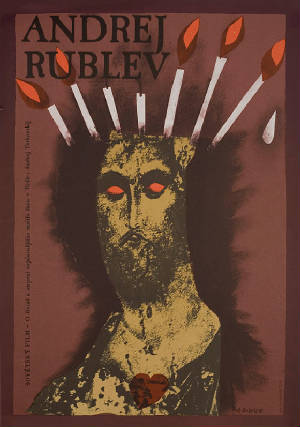|
|
 |
|

(1966, directed by Andrei Tarkovsky)
- inducted 2017 –
“Andrei Rublev is a medieval epic as only Andrei Tarkovsky could have envisioned it: impressionistic, moody,
dreamlike, thick with rain and fog and mud. From the very first sequence, in which a peasant crudely fashions a hot-air balloon
and briefly sails through the sky before crashing to earth, we knew we are far from the territory of the Hollywood biopic.
For Tarkovsky, the life of the titular painter of religious icons is only a jumping-off point for a series of episodes about
the plight of the artist, and about the creative challenges of working under regimes of repression and violence—conditions
to which Tarkovsky himself was no stranger. (Andrei Rublev suffered from censorship problems, and the circulation
of its many different cuts continues to stymie critics and audiences.)
“Divided into eight chapters, plus a prologue and an epilogue, the film follows its central character (Anatole Solenitsyn)
over the course of some twenty years as he struggles with his artistic conscience, eventually renounces his craft, takes a
vow of silence, and is eventually inspired to paint (and speak) again after witnessing a seemingly miraculous act of faith.
Many of the film’s sequences involve Rublev only indirectly, as a witness to key events; others play like reveries or
fantasies. Tarkovsky widens his frame of view so that the film is not only the story of Rublev the man but also a panorama
of the historical conditions out of which his art is born, and an allegory for the creative process.
“The film is also a triumph of cinematography and production design in which Tarkovsky manages to create the illusion
of an entire medieval universe, through which his camera roams freely. Using almost no interior sets, and shot almost entirely
in black and white through a kind of gray haze, Andrei Rublev is a superb example of Tarkovsky’s command of mise-en-scene.
Its fecund, dripping, mist-drenched exteriors look ahead to the worlds Tarkovsky would go on to build in subsequent films:
the forest of his childhood memories in Mirror (1974), the post-nuclear landscapes of Stalker (1979). We can
also see the influence of his world-building in such recent films as Aleksei German’s Hard To Be A God (2015),
a kind of nightmare inversion of a Tarkovsky film in which contagion is inevitable and grace is impossible. But no other
filmmaker has ever rivaled Tarkovsky’s ability to make the dreariest of settings feel sublimely beautiful. Andrei
Rublev is a testament to the power of the artist to transcend—and transform—the world around him.”
~ Ian Scott Todd
|
 |
|
Original title: Andrey Rublyov
Principal cast: Anatoly Solonitsyn, Nikolai Grinko, Nikolai Sergeyev, Nikolai Burlyayev, Ivan Lapikov, Yuri Nikulin, Yuriy
Nazarov, Rolan Bykov, Irma Raush, Mikhail Kononov, Nelly Snegina, Nikolay Glazkov, Bolot Beyshinaliyev, Irina Miroshnichenko
Written by Andrey Mikhalkov-Konchalovskiy and Andrei Tarkovsky
Produced by Tamara Ogorodnikova
Director of photography Vadim Yusov
Production design by Evgeniy Chernyaev
Costume design by Maya Abar-Baranovskaya, Lidiya Novi
Film editing by Tatyana Egorycheva, Lyudmila Feiginova, Olga Shevkunenko
Original music by Vyacheslav Ovchinnikov
Makeup by Maksut Alyautdinov, S. Barsukov, Vera Rudina
Sound by Inna Zelensova
Special effects by Pavel Safonov, V. Sevostyanov
Historical consultants M. Mertsalova, V. Pashuto, S. Yamshchikov
USSR
Duration: 205 minutes
Languages: Russian, Italian, Tatar
Filmed in black and white [featuring scenes in color]
Sound mix: Mono
Cinematographic process: Sovscope (anamorphic)
Aspect ratio: 2.35:1
Printed film format: 35mm
Produced by Mosfilm and Tvorcheskoe Obedinienie Pisateley i Kinorabotnikov
Released in a terrible hacked-up version in USA by Columbia Pictures
Premiered in the Soviet Union in December 1966
USA release date: 1973
Awards and honors:
- Cannes Film Festival, 1969: FIPRESCI Prize (winner)
|
 |
|
|
 |
|
|
 |
|
|
|
|
|
|
 |

